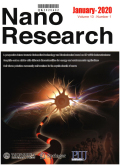- 钛学术文献服务平台 \
- 学术期刊 \
- 基础科学期刊 \
- 物理学期刊 \
- 纳米研究(英文版)期刊 \
Efficient fully blade-coated perovskite solar cells in air with nanometer-thick bathocuproine buffer layer
Efficient fully blade-coated perovskite solar cells in air with nanometer-thick bathocuproine buffer layer
基本信息来源于合作网站,原文需代理用户跳转至来源网站获取
摘要:
Fully printed perovskite solar cells (PSCs) were fabricated in air with all constituent layers,except for electrodes,deposited by the blade coating technique.The PSCs incorporated,for the first time,a nanometer-thick printed bathocuproine (BCP) hole blocking buffer using blade coating and deposited at relative humidity up to 50%.The PSCs with a p-i-n structure (glass/indium tin oxide(ITO)/poly(3,4-ethylenedioxythiophene) polystyrene sulfonate (PEDOT:PSS)/CH3NH3PbI3/6,6]-phenyl-C61-butyric acid methyl ester(PCBM)/BCP/Ag) delivered a maximum power conversion efficiency (PCE) of 14.9% on an active area of 0.5 cm2 when measured under standard test conditions.The PSCs with a blade coated BCP delivered performance of 10% and 63% higher (in relative terms) than those incorporating a spin coated BCP or without any BCP film,respectively.The atomic force microscopy (AFM) showed that blade coated films were more homogeneous and acted also as a surface planarizer leading to a reduction of roughness which improved BCP/Ag interface Iowering charge recombination.The demonstration of 15% efficient devices with all constituent layers,including nenometer-thick BCP (~ 10 nm),deposited by blade coating in air,demonstrates a route for industrialization of this technology.

推荐文章
基于串行 RapidIO的 Buffer层设计
buffer
RapidIO
流量控制
Snowball Earth at low solar luminosity prevented by the ocean–atmosphere coupling
Faint Young Sun paradox
Carbon dioxide
Earth system
Siderite
基于性能相似度的Buffer库压缩算法
buffer库压缩
性能相似度
虚单元
聚类
加权距离
内容分析
关键词云
关键词热度
相关文献总数
(/次)
(/年)
引文网络
引文网络
二级参考文献 (55)
共引文献 (1)
参考文献 (64)
节点文献
引证文献 (0)
同被引文献 (0)
二级引证文献 (0)
1983(1)
- 参考文献(1)
- 二级参考文献(0)
2003(1)
- 参考文献(0)
- 二级参考文献(1)
2009(3)
- 参考文献(1)
- 二级参考文献(2)
2010(1)
- 参考文献(0)
- 二级参考文献(1)
2011(3)
- 参考文献(1)
- 二级参考文献(2)
2013(4)
- 参考文献(2)
- 二级参考文献(2)
2014(10)
- 参考文献(5)
- 二级参考文献(5)
2015(23)
- 参考文献(8)
- 二级参考文献(15)
2016(24)
- 参考文献(11)
- 二级参考文献(13)
2017(26)
- 参考文献(12)
- 二级参考文献(14)
2018(10)
- 参考文献(10)
- 二级参考文献(0)
2019(8)
- 参考文献(8)
- 二级参考文献(0)
2020(5)
- 参考文献(5)
- 二级参考文献(0)
2021(0)
- 参考文献(0)
- 二级参考文献(0)
- 引证文献(0)
- 二级引证文献(0)
引文网络交叉学科
相关学者/机构
期刊影响力
纳米研究(英文版)
主办单位:
清华大学
出版周期:
月刊
ISSN:
1998-0124
CN:
11-5974/O4
开本:
出版地:
北京市海淀区清华大学学研大厦A座5-7层
邮发代号:
创刊时间:
语种:
eng
出版文献量(篇)
2324
总下载数(次)
1
总被引数(次)
5935
期刊文献
相关文献
推荐文献

 免费查重
免费查重










